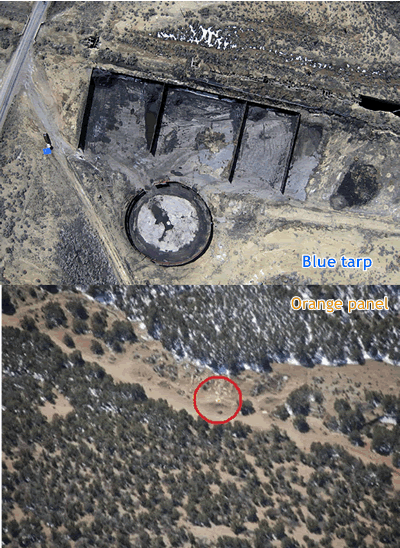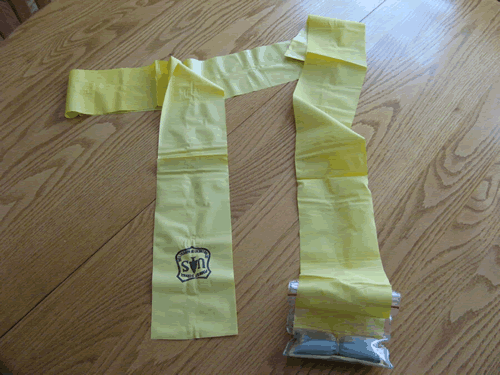
If you go truly “remote wilderness” for an extended period of time, chances are you will need to resupply. Many times, that resupply will come in the form of an “airdrop”. Here, we talk a little about that and explore a change of airdrop plans and communicating with the pilot in various forms.
It’s been four days since you left Rupert House on James Bay. You have seen one freighter canoe pass by as your group paddles their sea kayaks north on the arctic ocean. You are expected to be at Cape Jones today for an airdrop, but. . . you won’t be there. You still have 90 km to go. Wind and tide were against you and frankly, the “still” melting ice hasn’t help.
You know that you are under the flight path of your resupply aircraft, a de Havilland Canada Beaver. So, how do you let them know where you are? Well, you could call them on the radio? You’d probably be violating a few rules there. Even as a licensed Ham operator, aviation bands are out of your frequency range – though most radios can still receive in that range. Emergency, yeah you could transmit – if you radio is capable, but to get your supply of skittles and whiskey – probably not.
You land on a rocky island right under the flight path of your resupply aircraft. You expect the plane, and the lovably grumpy pilot, to be cruising at 3,000 to 5,000 feet above you in about an hour. So let’s get started.
First, shine up those signaling mirrors, compass mirrors, your old “U2” music CD’s, anything that can reflect sunlight. The plane will be approaching from the south, where the sun is shining and a signal mirror will work great. Especially with 10 people reflecting 10 mirrors at the aircraft.
Have you ever used a signal mirror? Do they really work? Yeah, they do. They work great. First, if everyone is flashing at Old Dudley, he’ll notice it. As someone who has had his attention caught by a signal mirror – they work well. The flashes will make you wonder, “what is that”. After pinpointing them you will realize, those flashes are on purpose and you will almost assuredly check it out. The video shows multiple signal mirrors in action from about a mile distant, then a few more examples of their effectiveness.
One thing we would like to note. Many signaling kits recommend the addition of a laser pointer for signaling aircraft. Please don’t do that. Laser pointers are not safe for pilots and their vision. In fact, if you use it to signal a Coast Guard aircraft, the pilots are immediately grounded until they can get a physical exam due to the damage that can be caused by a laser pointing device. The particular device you have may not harm their eyesight, but you probably don’t wanted to be the cause of an aircraft grounding, an flight crew being out of service and the logistics involved in getting a physical exam of the crew. Just don’t do it.
OK. So you got his attention. What now. Well, let’s have him drop the stuff in a certain spot. How do we do that? We could use an orange signal panel or spread out a tarp. If we do, keep in mind . . believe it or not, an orange signal panel isn’t the “ideal color” for marking a DZ (drop zone). In fact, for high altitude jumps, many military units actually use an 8′ x 10′ blue tarp instead (or a 6×8 for lower altitudes). It is the same popular blue tarp that everyone uses to cover things from the weather.
According to the National Association for Search and Rescue – “Royal Blue” is a color that is not present in nature and is actually the best option for getting attention. Don’t believe that? Take a look at the picture below.
To be fair these aren’t a perfect comparison, but the blue tarp does make a good contrasting color in almost every environment. You can see the effectiveness of blue tarps while flying over a disaster area, this picture is from the aftermath of Hurricane Katrina. Notice how the blue tarps look very bright and contrast very well.

All right, so we spread the tarp out and secure it for our expected aircraft. Now what? We have a strategy for getting the pilot’s attention – multiple signal mirrors. And we have a place for him to focus on – the blue tarp. But, how do we tell him to make the drop? Further, how do we communicate other intentions?
Since the blue tarp gives him a place to focus, let’s try to tell him where to drop the supplies. There is a standard format for ground to air signals and most pilots should have documents in the aircraft that explain GTA signals. So, first – let’s tell him where to drop supplies. Well, lets try to do that, because this part gets a little difficult.
Unfortunately, the signal for “Drop Supplies” isn’t well know. The letters “T Z” mean “Drop Here”, but as luck would have it, Canada is one of the countries that didn’t agree to that signal. You can try “T Z”, but a better option may be to spell out “D Z”. Keep in mind, it is NOT a recognize international symbol. Actually, there isn’t a universal “Drop Here” signal that is well known. You can also use the arm signal for “Use Drop Message” in the direction of the tarp in addition to your letter signal. “D Z” is well know to military pilots as slang for Drop Zone.
Don’t use an “X” to mark the drop zone, because that means you “Require Medical Assistance”. Essentially, you should have memorized these Ground to Air Signals in your basic outdoor training.
Will this work? Maybe. To increase your chances, you can let the pilot know that you have a radio receiver (Your HAM Radio) and you can receive his transmission – then answer him with the signals for “Yes” or “No”. The frequencies you would most likely use are 126.7 MHz in Canada and 123.5 MHz (121.5 MHz standby) in the United States.
Can a HAM Radio receive radio calls from Airplanes? Yes – most of them can receive – they just can transmit, unless you modify the radio. The following video is an aviation distress call received on a HAM radio during a search for the aircraft transmitting that call. Distress calls for some aircraft are transmitted on 121.5 MHz – the “stand by frequency” in the US. (Remember, in an “bona-fide” emergency, you can transmit on that channel for help.) The ELT (Emergency Locator Transmitter) that made this call was inadvertent and not actual distress. (No aircraft were harmed in the making of this video, it was accidently activated).
Once the pilot knows you are able to receive his transmission, he can ask you a question and you can answer “Yes” or “No” using the above ground to air signals.
After a number of exchanges, you should be able to work out the details.
While these techniques do not guarantee success, you could also violate communications laws and go ahead and transmit on his frequency. “If” you know his frequency. But, do so at your own risk.
Keep in mind, air dropping is difficult. Pilots have a difficult job to keep a plane airborne, so they usually have someone on board to make the drop. Also, accuracy is difficult from a aircraft unless you have some training and experience, so keep alert and well away from the target. Drops can also be very difficult to see, so make sure the crew knows (in your pre-trip, airdrop instructions) that supplies should have a streamer attached so you can see their flight path into the bushes or ocean.
We’ll talk more about setting up a drop zone (target zone) and about receiving an air drop in later posts. Stay tuned.
Till next time. . .
-Chuck Hayden
Director of Expedition Resources/Expedition Leader
Fortune Bay Expedition Team



